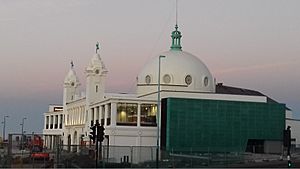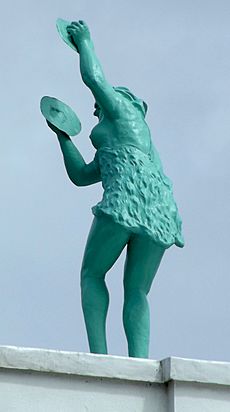Spanish City facts for kids
Quick facts for kids The Spanish City |
|
|---|---|

Renovation work, June 2018
|
|
| Alternative names | Whitley Bay Pleasure Gardens |
| General information | |
| Status | Grade II listed building (the dome) |
| Address | Watts Road, Whitley Bay, Tyne and Wear, England |
| Coordinates | 55°02′51″N 1°26′51″W / 55.047616°N 1.44747°W |
| Opened | 14 May 1910 |
| Renovated | 2011–2018 |
| Renovation cost | £10m |
| Client | Whitley Bay Pleasure Gardens Ltd |
| Owner | North Tyneside Council (June 2011) |
| Dimensions | |
| Diameter | 180 ft long, 275 ft deep |
| Design and construction | |
| Architecture firm | Cackett and Burns Dick |
| Structural engineer | L.G. Mouchel |
| Main contractor | Davidson and Miller |
| Renovating team | |
| Architect | ADP |
| Renovating firm | Robertson, Gateshead |
The Spanish City is a fun place to eat and relax in Whitley Bay. This seaside town is located in North Tyneside, Tyne & Wear, England. It was built to be like a smaller version of Blackpool's Pleasure Beach.
The Spanish City first opened in 1910. It had a concert hall, a restaurant, a roof garden, and a tearoom. Later, a ballroom was added in 1920, and then a permanent funfair. The building is famous for its unique dome, which is now a special protected building. It has a Renaissance-style front that is 180 feet long. On each side of the entrance, there are copper statues of women. One holds cymbals, and the other has a tambourine.
The band Dire Straits even sang about the Spanish City in their 1980 song, "Tunnel of Love". For a while, this song was played every morning when the Spanish City opened. By the late 1990s, the building started to fall apart. It closed to the public in the early 2000s. A big project to fix it up began in 2011. The Spanish City reopened as a dining and leisure centre in July 2018.
Contents
Building Design and Features
The Spanish City faces the sea. Its front is 180 feet long, and the building goes back 275 feet. The famous dome rises 75 feet high from the ground. It is 50 feet wide. The dome is made of strong concrete, about five inches thick. It is held up by 12 concrete columns that are 46 feet tall.
The main architects who designed the Spanish City were Robert Burns Dick, Charles T. Marshall, and James Cackett. The company that built it was Davidson and Miller.
History of the Spanish City
The idea for the Spanish City came from Charles Elderton. He ran the Hebburn Theatre Royal. Since 1907, his group, the Toreadors Concert Party, had put on outdoor shows in Whitley Park. Their tents were decorated in a Spanish style. To make a permanent place for fun, Charles Elderton started Whitley Amusements Ltd.
The famous dome was built in 1910. The Spanish City and Whitley Bay Pleasure Gardens officially opened on May 7, 1910. Robert Mason, who was in charge of the local council, opened it. The flag was at half-mast because King Edward VII had died the day before. Inside, there were shops, cafes, and a roof garden. There was also the Empress Theatre, which could hold 1,400 people on the main floor and 400 on the balcony.
Later, more parts were added. The Empress Ballroom opened in 1920. The Rotunda was added in 1921. In 1979, the Rotunda became the Starlight Rooms, a place for live shows. In the 1980s, the dome was even used as a classroom for students from Whitley Bay High School. It later became a place for live music, with bands like Ash playing there in 2001.
Many famous musicians have memories of the Spanish City. Mark Knopfler, the songwriter for Dire Straits, grew up nearby. He said the Spanish City was the first place he heard really loud rock and roll. The musician Sting also spent time there when he was supposed to be studying.
On July 27, 2014, a magician named Chris Cross was the last person to perform in the original Spanish City dome. This happened just before construction workers started fixing the building. Chris Cross performed magic tricks with help from Doctor Diablo. There was also a fire show outside by a local performer named Charlie Burns.
Whitley Bay Funfair History
In 1909, a company called Whitley Pleasure Gardens Company Ltd. was formed. They built a large funfair next to the Spanish City. This funfair was very popular. It had many rides and games.
Some of the exciting rides included a "corkscrew" roller coaster. This roller coaster later moved to Flamingoland in Yorkshire. There was also a ghost train and waltzers. Other attractions were the House that Jack Built, the Joy Wheel, and the Fun House. A ride called Ye Olde Mill took people on boats through a tunnel. The tunnel had different scenes, like a Swiss valley and a fairy castle. From 1909 to 1974, there was also a figure-eight railway at the fairground.
In June 1914, a new ride called the Rainbow Pleasure Wheel was added. It came from the United States and could reach speeds of about 40 miles per hour. The Spanish City Dome itself later held an amusement arcade. It also had a Laser Quest Laser Tag arena.
By the mid-1990s, the funfair started to get old and worn out. It closed down in 1999. In December 1999, it was announced that the fairground would be taken down.
And now I'm searching through
these carousels and carnival arcades
Searching everywhere
from Steeplechase to Palisades
And any shooting gallery
where promises are made
To Rockaway, Rockaway
Rockaway, Rockaway
From Cullercoats and Whitley Bay
Out to Rockaway.
And girl it looks so pretty to me
Like it always did
Like the Spanish City to me
When we were kids.
Bringing the Spanish City Back to Life
In June 2011, an architecture company called ADP won a project. Their plan was to bring the Spanish City back to life. The plan included a 50-room hotel, 20 apartments, a 1950s-style diner, and a new pleasure garden. It was hoped the work would be finished by 2014. However, work stopped in 2013 because there wasn't enough money.
In November 2013, the project received a grant of £3.7 million. This money came from the Heritage Lottery Fund. With new funds, the work continued. The Spanish City finally reopened in July 2018.
Images for kids







